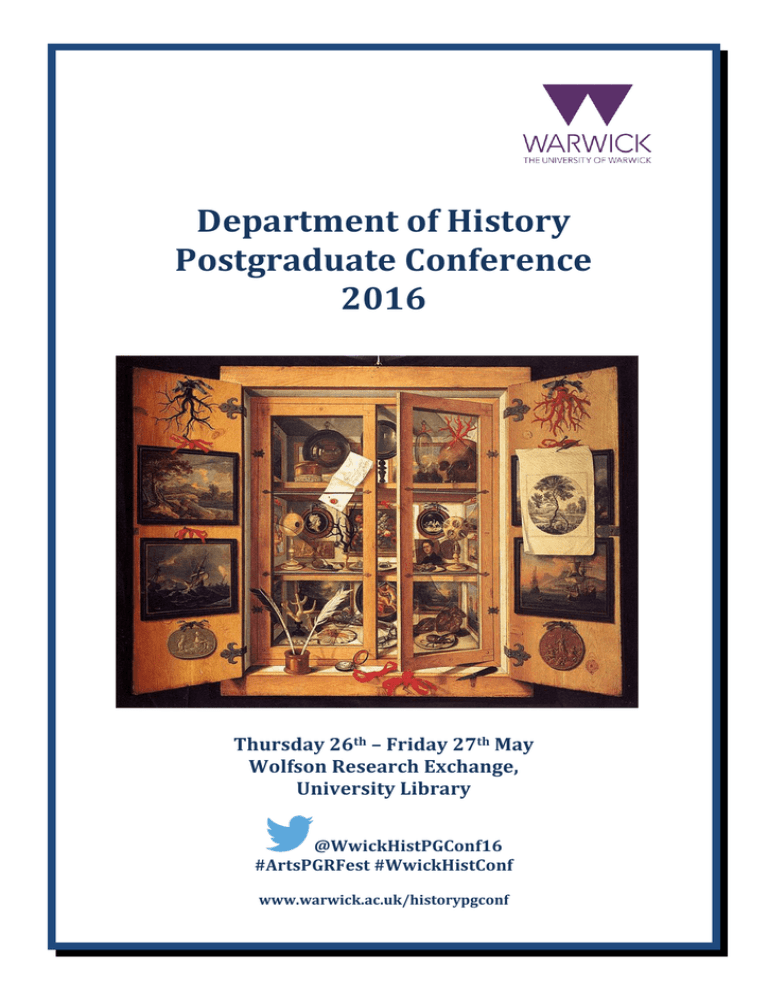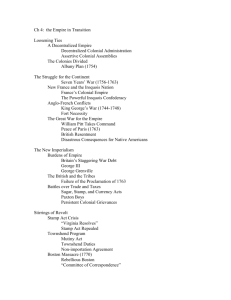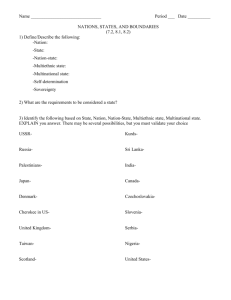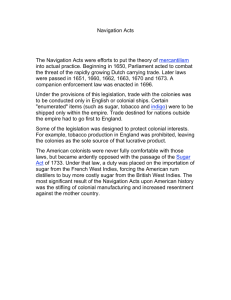Department of History Postgraduate Conference 2016
advertisement

DepartmentofHistory PostgraduateConference 2016 Thursday26th–Friday27thMay WolfsonResearchExchange, UniversityLibrary @WwickHistPGConf16 #ArtsPGRFest#WwickHistConf www.warwick.ac.uk/historypgconf HISTORYDEPARTMENT UNIVERSITYOFWARWICK HISTORYPOSTGRADUATECONFERENCE 2016 OrganisingCommittee NatalieCox HannahGraves BenjaminRedding CONFERENCEPROGRAMME 1 THURSDAY26THMAY 1 FRIDAY27THMAY 3 ABSTRACTS 5 THURSDAY26THMAY 5 PANEL1 MOBILITY,EMPIRE,ANDTHEEMOTIONS,C.1680S-1890S 5 PANEL2 EARLYMODERNENGLAND 7 PANEL3WORDS,SOUNDS,ANDVISIONS:HISTORICIZINGPOPULARCULTURE10 FRIDAY27THMAY 13 PANEL4 HEALTHANDWELL-BEINGINMODERNBRITAIN 13 PANEL5 ECONOMICS,TRADEANDEMPIRES 14 PANEL6 COLONIALANDPOST-COLONIALEASTAFRICA 16 PANEL7 EMPIREINNINETEENTHCENTURYINDIA 18 CONFERENCEPROGRAMME THURSDAY26thMAY WolfsonResearchExchange,UniversityLibrary 10.15-10.50 Registrationandcoffee 10.50-11.00 Welcome,DirectorofGraduateStudies 11.00-12.30 PANEL1 MOBILITY,EMPIRE,ANDTHEEMOTIONS,c.1680s-1890s Chair:ProfessorDavidLambert • • • Insearchof‘whitegold’:Negotiatingspaceandmobilityonthe‘saltislands’ oftheBritishCaribbean,c.1680s-1810s. KimberleyThomas Madness,emotionalregimesandgovernanceintheBourbonMexican missions RebeccaNoble ‘EasyChairGeographyversusFieldGeography’:Imperialmobilityandthe cultureofBritishexplorationinthenineteenthcentury NatalieCox 12.30-13.30 Lunch 13.30-15.30 PANEL2 EARLYMODERNENGLAND Chair:ProfessorMarkKnights • • • • TheExperimentalNatureofElizabethanMaritimeFinance BenjaminRedding TheGreatEjection:theimpactinWarwickshireofthe1662Actof Uniformity DavidFletcher Anglo-OttomanDiplomacyduringtheSeventeenthCentury:TheEmbassyof SirThomasRoe,1621-8 CharlesBeirouti Antiquities,Past,andPresent:TheTradescantCollectionanditsRarities ChristopherHunt 15.30-16.00 Coffee 1 16.00-18.00 PANEL3 WORDS,SOUNDS,ANDVISIONS:HISTORICIZINGPOPULAR CULTURE Chair:Dr.SarahRichardson • • • • WritingattheMargins:RecoveringJaneWhite’sPinky(1949) HannahGraves The‘completewesternexperience’:RedDeadRedemption,Cinemaand History EstherWright TheActivists’Playlist:TheShiftingRelationshipBetweenPopularMusicand PoliticalActivism DavidToulson 'Themosttrustedvoiceinmusic':comparingtwoleadingmusicreviewing websites JamesBennett 18.00–19.30Drinksreception,WolfsonResearchExchange ENDOFDAYONE 2 FRIDAY27thMAY 9.00–9.30 Registrationandcoffee 09.30-10.30 PANEL4 HEALTHANDWELL-BEINGINMODERNBRITAIN Chair:DrRobertaBivins • • Theriseofthesunbedindustry:‘Tanorexia’amongwhiteBritishfemales: Liverpool,2006-2016 FabiolaCreed From‘DrCarrot’to‘Concreteingardenmaking’:domesticdesign,health andthegardeninpost-warBritain SophieGreenway 10.30-11.00 Coffee 11.00-12.30 PANEL5 ECONOMICS,TRADEANDEMPIRES Chair:ProfessorDavidAnderson • • • PerceptionsofProductionandtheRetailingandMarketingofQuality MetalwareinEighteenth-CenturyEngland RachaelMorton Were‘Chinesegoods’fromChina?Issuesofproductidentification,technical transfersandappropriationsintheEighteenthCentury SébastienPautet UsingNineteenth-centuryAfricanPhotographyasEvidenceofTextile Consumption JosephineTierney 12.30-13.30 Lunch 13.30-15.00 PANEL6 COLONIALANDPOST-COLONIALEASTAFRICA Chair:ProfessorDanielBranch • • • Connectinghistoriesonthemarginsofempires:colonialisms,tradeand transformationsofterritorialityintheSomalia-Kenyaborderlands,c.19251930 AnnaBruzzone Insearchofarevolution:A.M.Babu,Tanzanianpolitics,andtheglobal Marxiststruggle GeorgeRoberts FinancingcolonialKenya:Thebankingsystemduringthelastdecadesof colonialrule ChristianVelasco 3 15.00-15.30 Coffee 15.30-17.00 PANEL7 EMPIREINNINETEENTHCENTURYINDIA Chair:DrRobertFletcher • NotionsofempireonEastIndiaCompanycoins,1770-1840 DavidMolyneux • ‘AnEnglishgentlemanshouldalwaysbedressedsothatsuddenlydropped intoBondStreet,hewouldpassunnoticed’:MaterialCultureandIdeasof MasculinityinNineteenthCenturyIndia HollyWinter • ChildMarriageandFemaleEducation:HinduandMuslimWomen’sSocial ReforminLateColonialIndia,1885-1940 SaberaKara 17.00 Conferenceclosingremarks,DirectorofGraduateStudies 4 ABSTRACTS THURSDAY26thMAY PANEL1 MOBILITY,EMPIRE,ANDTHEEMOTIONS,c.1680s-1890s Kimberly Thomas – In search of ‘white gold’: Negotiating space and mobilityonthe‘saltislands’oftheBritishCaribbean,c.1680s-1810s. Islands are elusive spaces. On the one hand, they appear closed and bounded with definable, self-evident, natural boundaries. Yet, at the same time, the rich maritime connections that connect their shores with others defy capture (Rod EdmondandVanessaSmith,IslandsinHistoryandRepresentation,2003).These connections–multifariousexchangesofpeople,goodsandideas–makestudying boundariesintheearlymodernAtlanticworldfascinatingbutcomplex. InacasestudycenteringontheTurksandCaicosIslands(TCI),Iadopta cis-Atlantic framework in order to reveal not only how these islands were initially settled and worked by migrating Bermudian seafarers, but also how afteracenturyofdefactoBermudianruletheybecamehighlycontestedground. Though foreign predations consistently leered, the real battleground cracked openwithintheBritishEmpireasadiplomaticwarragedbetweentheBahamas and Bermuda for sovereignty over these saline spaces. Who had rights to the naturalresourcesofthesesalt-richislands?Throughacloseanalysisoftheplans andcolonialpetitionsthateruptedaroundthissituationinthelate1780s,Iwill show how actors on the ‘margins’ framed arguments around sovereignty, with London consistently playing catch-up before ruling in favour of TCI annexation to the Bahamas in 1799. Yet, despite this political change towards de jure Bahamianrule,socio-economictiespersistedbetweenBermudaandtheTCI.As such,thispaperwillarguethat,duringtheearlymodernperiod,theTCIwerea goodexampleofhowboundarieswerebothdrawnanddefied. Rebecca Noble - Madness, emotional regimes and governance in the BourbonMexicanmissions Historical analysis of cases of ‘mad’ missionaries in eighteenth-century Mexico providesanopportunitytoconsiderunderstandingandexpressionofemotions often hidden in the historical record. Fear, sadness, anger and other kinds of mentaldistresscanbefoundinthepersonalandbureaucraticcorrespondenceof missionaries and other religious and medical authorities regarding the mental statesof‘mad’missionaries. 5 This paper examines correspondence found in missionary records in order to place discourses on madness in their religious and medical context. It explorestheimportanceofthesensesinindividualandcommunalperceptionsof ‘mad’ individuals and considers the importance of specific historically situated emotional regimes in understanding what madness was understood as in Bourbon Mexico, how it was labelled, and the consequences of this process for governanceofmissionariesandsocietymorebroadly. Particularattentionispaidtothespatialandenvironmentalfactorswhich werecentraltounderstandingsofemotionalandmentalimbalanceinBourbon Mexico.Thesourcesdiscussedareusedtoaskthefollowingquestions:howdid historical actors draw on humoral models of the mind and body in order to conceptualise illness and spiritual isolation experienced by some missionaries? In what ways did missionaries adapt longstanding religious and medical traditions to the new circumstances of their work? How were mental and emotionaldistressperceivedinspacesofculturalcontactandexchange?These questions address developments in religious and scientific knowledge in this period and their implications for communal understandings of individual behaviour. Natalie Cox - ‘Easy Chair Geography versus Field Geography’: Imperial mobilityandthecultureofBritishexplorationinthenineteenthcentury Nineteenth-century projects of exploration came to be defined by the practical experience of moving across unknown spaces. The ‘explorer’ emerged in this periodasthemissionaryofthispurportedlymanlypursuit,travellingtoextend the frontiers of European geographical knowledge. However, the place of exploratorytravelwithinthenewlyemergingscienceofgeographywasthefocus of heated debates throughout the nineteenth century. This paper engages with these discussions to examine the different practices of mobility apparent in makinggeographicalknowledge.Itintroducesthe‘easychairgeographer’asan overlooked,yetimportantaspectoftheVictoriancultureofexploration.Despite not physically going to the places they wrote about, these sedentary practitioners explored by reading, collating and, synthesising texts. Drawing on recentworkinmobilitystudiesandhistoricalgeographiesofscience,thispaper movesbeyondlookingatthespatialboundarybetweentheexplorerinthefield andthescholarinthestudy,tofocusonthebodilycomportmentofgeographers withinthesespaces.Itaddressestheexperiencesofimperialmobilitythrougha critical study of the movement of two, seemingly, contrasting geographical practitioners:sedentarygeographer,WilliamDesboroughCooleyandmissionary explorer,DavidLivingstone.Inreconstructingtheirexperiences,itisshownhow their bodies became bound up with meanings of both action and stasis. These discussions are animated by the personal dispute between Cooley and 6 Livingstone,expressedinLivingstone’s1856letter,titled‘EasyChairGeography versusFieldGeography’. In tracing the physical contours of this debate, this paper unravels a complextaleofexploratorymovementandexposesthefabricateddichotomyof mobility/immobility that has simplified the history of geography as an active scienceofEmpire. PANEL2 EARLYMODERNENGLAND Benjamin Redding – The Experimental Nature of Elizabethan Maritime Finance Although the English victory over the Spanish Armada, and the celebrated seadogssuchasFrancisDrake,andWalterRaleigh,arewellknown,theattention that the Elizabethan navy receives both in academic circles, and in popular culture, is often misrepresented. The great Elizabethan navy is somewhat of a myth; in size and strength, English naval resources in 1603 were not too dissimilar from that of the early Elizabethan regime. Moreover, the navy’s decline under James I serves to almost oust Elizabeth I from her throne as the mother of English sea power. With this said about the navy, the Elizabethan desperationtosustainapermanentmilitaryforceatsea,resultedinanumberof atypicaleconomicreforms,whichdoesallowElizabeth’sreigntostandoutfrom the crowd. This paper will explore three extraordinary methods used during ElizabethI’sreigntoraiserevenueforthekingdom’sambitiousmaritimepolicy. Firstly, it will trace William Cecil’s scheme for a National Lottery in the late 1560s. This will be followed by a broader consideration of privateering, which will apply particular attention to the expeditions that were not officially state endorsed.Finally,thelateElizabethanshipmoneylevywillbeexplored.Through doing so, it will be argued that the Elizabethan state was conscious of the importanceofanavytonationaldefencefromtheveryonsetofElizabeth’sreign. Moreover, although the supremacy of the Elizabethan navy is often overstated, Elizabethandhercouncil’sambitiontoretainastrongnavyisrepresentedina willingness to advance the English fiscal system through trial and error. Although failing at almost every turn to accumulate sufficient income for the navy, the experimental nature of the late sixteenth century English state, introducedfarearlierthanisoftenasserted,theideaofafiscal-navalsystem. David Fletcher - The Great Ejection: the impact in Warwickshire of the 1662ActofUniformity The entanglement of religious intoleration with power and high politics continuestobeapotentissueinthemodernworld.Inlate17thcenturyEngland thishazardouscocktailresultedinaprogrammeofaggressivelegislationandan 7 atmosphereofintensereligiousconflict.Whilenegotiatinghisreturn,CharlesII had promised ‘a liberty to tender consciences’. But, after the Restoration, the new MPs and Church leaders were not interested in tender consciences. Their priority was universal conformity with the doctrines and practices of the restored Church of England - and they turned to the law as their weapon for enforcingthis.Oneoftheselaws,the1662ActofUniformity,requiredallclergy to swear to uphold the Book of Common Prayer. This became a matter of conscience for many clergy across the country, particularly those who were appointedduringtheInterregnum.Almosttwothousandmenwerenotprepared totaketheoathandsolosttheirpositionsinwhatbecameknownastheGreat Ejection. This paper will explore the impact in Warwickshire of the Act of Uniformity.Thirty-threeclergywereejectedfromparishesinthecountyin1662. But beneath this apparent success for the regime, there lies a more complex picture. Legislation created in Parliament would only be effective if it was enforcedatthelocallevel.InWarwickshire,manyoftheejectedclergycontinued topreachinthecountyand,ontheoccasionswhentheregulationswererelaxed, dissentingmeetinghousesquicklysprangup.Ifacultureofnonconformityand dissent could endure as an important element of the religious life of an unexceptional county such as Warwickshire, this top-down attempt to enforce uniformityandpreventreligiousschismhadclearlyfailed. Charles Beirouti - Anglo-Ottoman Diplomacy during the Seventeenth Century:TheEmbassyofSirThomasRoe,1621-8 Over the last few decades, historians have dramatically expanded and transformed the historiography of European-Ottoman relations. They have increasingly acknowledged that Europeans and Ottomans were consistently linked by more than simply conflict and hostility – that they also co-operated commercially, diplomatically and intellectually; and that cultural, religious and linguistic barriers were not as distinct or sustained as once thought. Much of their work has focused on so-called ‘intermediaries’; individuals or groups whoseprofessionsorsimplywaysoflifekepttheminconstantcontactwithboth EuropeandtheOttomanEmpire. The most obvious or visible of these intermediaries were diplomats. Indeed, European ambassadors naturally played a critical role in establishing and then sustaining multifaceted relations between Europe and the Ottoman Empire. My dissertation, which examines the diplomatic correspondence of Sir Thomas Roe (1581-1644) – the English ambassador to Istanbul from 1621 to 1628 – explores one aspect of this process. Early modern Anglo-Ottoman diplomacy remains relatively understudied, despite the almost continuous interaction that occurred between England and the Ottoman territories after diplomaticrelationswerefirstformallyestablishedin1580. 8 This paper will shed much-needed light on exactly how early modern connections – be they commercial, diplomatic, or cultural – manifested themselves, among ‘ordinary’ people as well as diplomats and other state officials. How did people construct, navigate, transcend, or sometimes break down connections, and what impact did this have? Crucially, this analysis will considerhowinformationtravelledacrossOttomanterritories.Thissubjecthas receivedonlyscantattentionamongscholars,whohavelongassumed–wrongly, this author believes – that because the Ottomans mostly lacked printing technologies before the nineteenth century, they were somehow unaware or uninterestedintheworldoutsidetheirborders. Christopher Hunt - Antiquities, Past, and Present: The Tradescant CollectionanditsRarities Thispaperexploresthephenomenaofearlymoderncollecting,focusingonthe Cabinet of Curiosities owned by the Tradescant family now housed in the Ashmolean Museum. Paying particular attention to the antiquities in the collection,thispaperexploresearlymodernwaysofseeinginrelationtothese artefacts,aswellashowtheseobjectsinfluencedideasofidentity.Beyondthis, the paper will examine the relationship between antiquities and relics; they sharecommonqualitiesandcouldbeseenassimilarobjectsdespitethehistoric andreligiouspropertiesofeach,andassuchwereoftenviewedinlights. The paper uses the collection of the Tradescant family, as well as its inventoryproducedbyJohnTradescanttheYoungerintheseventeenthcentury toexploreideasofantiquity,past,andpresent,andhowtheseartefactsfromthe pastactivelyshapedideasofEnglishidentityintheperiod.Thispaperdoesnot use grand narratives of nation building or a comprehensive, shared idea of England,butaimstoreconstructviewsofheritageandnatureinviewofobjects from the distant past. The nature of Wunderkammern will be discussed here, withtheorderofthingstheypossessedrelatingtotheorderingofearlymodern cosmologyandideasoftheworldandindeeduniverse.Attentionwillbegivento ideas of history in the sixteenth and seventeenth centuries, Cabinets of Curiosities and collections more widely, and the Tradescant collection in particulartodiscusshowantiquitiesandartefactsinteractedwithtextstoform ideasofEnglishidentityandheritageintheseventeenthcentury. 9 PANEL3WORDS,SOUNDS,ANDVISIONS:HISTORICIZINGPOPULAR CULTURE Hannah Graves – Writing at the Margins: Recovering Jane White’s Pinky (1949) A hybridised courtroom drama, maternal melodrama and social problem film, Pinky (Elia Kazan, 1949) has received no shortage of critical attention for its exploration of the identity crisis of Patricia “Pinky” Johnson (Jeanne Crain), a light-skinned woman of ambiguous mixed race ancestry. As one of the first offeringstoaclusterofHollywoodfilmsreleasedacross1949thattookAfricanAmericanracialdiscriminationasacentraltheme,filmscholarshavethoroughly documented Pinky’s production history. Yet, the influence of script consultant JaneWhite,aSmithgraduateandemergingactress,remainsunderexplored. The daughter of the NAACP’s Executive Secretary, Walter White, Jane’s contributions have often been minimised as unheeded suggestions on how to avoidracialcaricatureandanextensionofherfather’sadvicetoproducerDarryl F. Zanuck. Yet, as the only ‘race year’ film the NAACP decided not to endorse - findingittoo‘sentimental’tobetakenseriously-Jane’ssuggestionsabouthow to make Pinky an important woman’s picture differed significantly from her father’sconceptionofwhatagood‘raceyear’filmshouldlooklike.Asayoung, light-skinned African American actress, Jane found herself working to improve the depiction of a heroine that Hollywood’s casting colour-line would never consider for her. Meanwhile, as Zanuck doggedly pursued her father’s unforthcoming endorsement, her own contributions to the film remain uncredited. Recovering the NAACP’s often overlooked and highly gendered criticismsofPinky,thispaperanalysesJaneWhite’suniquecontributionstothe film’s production while recalling the double burdens that she suffered while workinginHollywood. EstherWright-The‘completewesternexperience’:RedDeadRedemption, CinemaandHistory This paper considers 2010 video game release Red Dead Redemption, as a self consciousattemptbyRockstarGamestorecreatetheWesterncinematicgenrein digital game form, as well as represent the ‘reality’ of life on the southwestern AmericanFrontierintheearlytwentieth-century.Redemption’slinearnarrative and open-world gameplay were marketed against a backdrop of the history of Western cinema—and deeply indebted to a specific kind of Western film— as wellasmoretraditional‘historicalresearch’.Redemptionisthuspromotedasa game grounded in both public and academic perceptions of America’s western history. Furthermore, through its overarching, meticulously created narrative structure,aspecificportrayalofAmerica’spastisretoldandcanbeexperienced 10 byplayers,whocontrolandplayasaparticularkindofWesterner.Moreover,it wasmarketedasagamethatactivelyrecreatesmany‘classicwesternsituations’, promising to immerse players within, and allow them to enact the ‘complete Westernexperience’initsvirtualgameenvironment.Thispaperconsiderswhich specificcinematicandhistoricalelementsareincorporatedintothegameitself, itsnarrativeandgameplayoptions,andthesubsequentvisionof‘history’thatis, as a result, privileged. Ultimately, it will question what kind of historical narrativeisbeingpreservedthoughthisgameandfromwhereitsdrawsitsmain inspirations,exploringthehistoricallegacyof‘theWest’thathasbeenpreserved incontemporaryentertainmentmedia. David Toulson - The Activists’ Playlist: The Shifting Relationship Between PopularMusicandPoliticalActivism In the Autumn of 2012 I began a PhD project considering the links between popular music and popular political activism in relation to anti-apartheid campaigning in Britain. From the outset the overwhelming majority of the literature on the political potential of popular music suggested a growing distancebetweenthetwo.Thatultimatelyattemptstoharnesspopularmusicfor explicitlypoliticalcampaigninglostouttothedistinctlylesspoliticalplatitudes ofLiveAid. This was a model that appeared to be confirmed by my own research. Attempts by the UK Anti-Apartheid Movement to enforce a complete cultural boycott of South Africa were undermined by increasing amounts controversy throughout the 1980s. Growing disputes about whether ‘progressive’ South Africanartistsshouldbeallowedexemptionfromtheboycott,appearedtosignal theinabilityofpoliticsandpopularmusictoexistinharmony.Thiscoupledwith popularmusic’sseemingambivalencetopoliticalissuesthroughouttheduration ofthe1990sand2000sappearedtoconfirmthisnarrative. Yet as I wrote the conclusion to my PhD in the summer of 2015 events appeared to suggest that this distance was not as insurmountable as had been suggestedbymany.TheelectionofJeremyCorbynasleaderoftheLabourParty and the rising prominence of Bernie Sanders in America, both flanked by supportive voices in popular music, raised questions about the way in which dialoguebetweenpopularpoliticsandpopularmusiccouldnotonlycontinueto existbutalsoflourish. InthispaperIwillconsiderthewaysinwhichthisapparentshiftinthe relationship between popular music and popular politics presents challenges andopportunitiestohistorians.Inparticularwhethertheserecenteventshelpto recapture forgotten stories which show continuity rather than change in the relationshipbetweenpopularmusicandpopularpolitics. 11 JamesBennett-'Themosttrustedvoiceinmusic':comparingtwoleading musicreviewingwebsites The emergence of the internet has totally changed the landscape of the music industry, with music far easier to obtain, listen to and store. Music criticism is one of many aspects to have been transformed. The popularity of hard copy music magazine has declined as the music website rose to prominence and popularity.Today,publicationssuchastheNMEfighttosurvivewhilebusinessis booming for websites such as Pitchfork and AllMusic; the ways in which music fanscanreadcriticisminthemid-2010sarenowradicallydifferenttothatprior tothedot-comboom.Whiletheoldpublicationshaveattemptedtojumponthe bandwagon and retain a presence in what is now a crowded marketplace, few havemanageditassuccessfullyasthestart-upwebsites. ThispaperwillcomparetwoAmericanwebsiteswhichhaveestablished themselves as leaders amongst the new generation of sources of criticism. Pitchfork was founded in 1995 as the personal reviewing website of Ryan Schreiber, but has since grown into one of the most influential websites in the industry,inparticularduetoitsfocusonindierock.AllMusicwasestablishedin 1991 as an attempt to review and compile information on every album ever released. It has grown into a lucrative business, selling its reviews and information on to third parties such as Microsoft, Apple and Amazon. Both websites have achieved their success in very different ways, with radically differentaudiencesandstyles,andyetarepartofthesamemovementtowards onlinereviewing. ENDOFDAYONE 12 FRIDAY27thMAY PANEL4 HEALTHANDWELL-BEINGINMODERNBRITAIN Fabiola Creed -The rise of the sunbed industry: ‘Tanorexia’ among white Britishfemales:Liverpool,2006-2016 Theindoortanningindustry,establishedbyFriedrichWolffin1978,proliferated in Britain during the 1980s. My developing dissertation will explore why particular regions, such as Liverpool, have more deeply embedded a tanned complexion into their culture compared to other British regions, andhow this hascontinueddespitetheincreasingawarenessofMelanoma. First, this paper will use quantitative data toassess an orthodox belief, supported by health officials such as Cancer Research UK, that higher concentrationsofsunbedsarepresentindeprivedurban,asopposedtoaffluent rural regions. I will alsoevaluatea statement quoted by many Britishnewspapersin-between 2010-2015, which reported thatLiverpool‘has sixtimesthenationalaverageoftanningsalonspercity’. The second part will utilise Michel Foucault's 'toolbox' of powertoexplore how the increasing measures of control within the sunbed industry -such as the mass advertising, panoptic setting, monitoring and fingerprinting technologies -has contributed to the prevailing popularity of a tanned complexion. This willevaluatethe relations of power between sunbed operatorsandtheirmostcommonusers:white,adolescentfemales.Drawingon medicaljournalsandnewspapersthatfeaturepersonaltestimonies,Iwillargue that thismisconstrued sense of pleasure and empowerment felt by sunbedusersleads to a dependent and addictive nature towards artificial tanning. This demonstrates how commercial drivers can challenge medical authorities,undermininghealth-promotinginterventionsfrompublichealthand medicalexperts. Sophie Greenway - From ‘Dr Carrot’ to ‘Concrete in garden making’: domesticdesign,healthandthegardeninpost-warBritain Atatimewhentherelationshipbetweenhealth,nutritionandtheenvironment is of increasing concern, this paper will explore how attitudes to the environment on our back doorstep were shaped in mid-twentieth-century Britain. During the post-war period, government, campaign groups and the mediapaidagreatdealofattentiontothedesignofthehealthyhome,seekingto reduce the numbers living in insanitary slums, and to improve the working conditionsoftherecentlyenfranchisedhousewife.Mypaperlooksatthewaysin which this focus on the domestic realm extended outdoors to the relationship betweenBritishpeopleandtheirgardens.Specificallyitexamineschangesinthe 13 way domestic food growing was represented in magazines after the Second World War. Whilst during the emergency of war the benefits of home growing forhealthwerewidelyextolled,bythe1960sthegardenwasportrayedasasite ofleisureandconsumption.Iwillexaminetheportrayalofhomesandgardens, in the context of health, in a varied range of magazines, such as the Cooperative’sWoman’sOutlookandVogue’sHouseandGarden.Werehomesshown with gardens? Was the garden shown as a healthy place? Was it a place of rest and leisure, or a place of home production? Or did it appear to be a source of potentialinfection,carriedinonthekneesofchildrenandthebootsofmen? PANEL5 ECONOMICS,TRADEANDEMPIRES Rachael Morton - Perceptions of Production and the Retailing and MarketingofQualityMetalwareinEighteenth-CenturyEngland TheexpansionofthemetalwaretradeinEnglandintheeighteenthcentury,and the rise of regional manufacturing towns such as Birmingham and Sheffield, challengedtheperceptionofqualitymetalware.Inparticular,theintroductionof new products and materials and the utilization of flexible organizations of productiongavetheconsumergreaterchoiceandenhancedthepubliccuriosity in manufacturing and innovation. These changes in production therefore impactedonthemarketing,andconsequentlytheretailingandconsumption,of metalware. Recent historiography has explored how individual retailers constructed their reputations for trustworthiness, as brokers of quality and taste. However, within the metalware trade in particular, the producer-retailer maintainedanimportantrole,aconspicuouspresenceinadvertisements,anda crucial influence in the perception of quality. By looking more closely at marketing strategies, this article sheds light on the metalware trade, and how consumer goods were marketed in the eighteenth century. Not only did the marketing of metalware involve the utilization of language and imagery in increasingly sophisticated methods of advertising in print, from newspaper advertisementsandtradecardstotradedirectories,butalsothedesignofshop spaces, networks of personal relationships and patronage from the social elite, andtheobjectsthemselves. Sébastien Pautet - Were ‘Chinese goods’ from China? Issues of product identification, technical transfers and appropriations in the Eighteenth Century Thedisseminationofso-called‘Chinesegoods,’‘Indiangoods’or‘Japanesegoods’ on European markets reveals the rise of consumerism and its connections to global trades during the eighteenth-century. But does the name reflect the 14 product? Between commercial strategies, market rhetoric and product identification, names of products can be seen as a quality label or a wonderful toolforcounterfeiting.Andforhistorians,productoriginconstitutesapuzzling problem. This paper thus examines how product names constitute a distorting mirror of the global dissemination of technical knowledge, adapted and reinterpreted locally by artisans and manufacturers in European context. By focusing on name issues, I will explain how the classification of products helps historianstounderstandthelinksbetweenglobaltradesandproductinnovation inEuropeduringindustrialization. Josephine Tierney - Using Nineteenth-century African Photography as EvidenceofTextileConsumption In tracing the consumption of British textiles in Africa during the nineteenth century the historian encounters a number of obstacles, most notably a lack of remaining documentary and object sources. Despite the transient nature of the textiles themselves, evidence of their consumption can be found in the many visualrecordsmadebynumerousphotographersinAfricaduringthenineteenth century. Photographing the landscape, people and diverse cultures of the continent became a preoccupation for Colonial administrators, missionaries, ethnographers, anthropologists and all kinds of amateur photographers. The collections of photographs they left behind indicate the material and geographical diversity of dress and textile consumption in Africa during this period, providing a vital source for historians of material culture. However, as historians,theoreticiansandphilosophershaveemphasisedphotographsposea numberofchallenges.Ithasbeenarguedthatphotographsaremoreareflection of the photographer than the subject, bringing into question important notions regardingpowerrelations,voyeurismandthegaze.Theseissuesofauthorityare reinforcedwhenconsideringphotographstakenwithinacolonialcontext,where the photographic subject is also the colonial subject. With these challenges in mind,isitpossibletouseAfricanphotographyasaprimarysourceforexamining material culture during the British Empire? And if so, how can the complex relationships, between master and subordinate, photographer and subject, coloniser and colonised, be negotiated in order to unpack the layers of representation. This paper will present work in progress and explore the difficulties and potential of using nineteenth-century photography as a source. Drawing on the work of Roland Barthes, Raphael Samuel and others, it will outline the theoretical context of using photography as a historical source and interrogatethemeritsofcurrentmethodologies.Itwillalsoexamineanumberof nineteenth-centuryphotographsindepthtoillustratethesethemes. 15 PANEL6 COLONIALANDPOST-COLONIALEASTAFRICA Anna Bruzzone - Connecting histories on the margins of empires: colonialisms, trade and transformations of territoriality in the SomaliaKenyaborderlands,c.1925-1930 Situated at the crossroads of the British, Italian and Ethiopian empires and lapped by the Indian Ocean trade routes, the Somalia-Kenya borderlands experiencedstructuraltransformationsinthesecondhalfofthe1920s.Withthe transfer of the Jubaland Province from the British Empire to Italy in 1925, the cleavages, interconnections and interdependencies that European imperialism hadcreatedintheSomalia-Kenyaborderlandssincethe1890swereprofoundly reconfigured. The new imperial border cut through a complex social universe whichhadbeenalocusofmigrations,warsandlocalre-compositionsofpower sincethemidnineteenthcentury.BritishandItaliancolonialauthoritiesinserted themselvesandwereaccommodatedintoasocialfabricwhichhadbeenshaped, andwasconstantlybeingtransformed,byconflictandassimilation,domination andcollusion.ColonialsourcesdrawnfromvariousarchivesintheUK,Italyand Kenya are used along with oral sources to explore this history, tracing the interactionsbetweeninter-imperialrivalries,colonialpracticesofexclusionand inclusion, and localised socio-political dynamics. These interactions reveal how power and customary authority were transformed, negotiated and institutionalised on the margins of the colonial state. This paper seeks to examinethesocialconstructionofsovereigntyintrans-nationalperspective,by focusing on the modalities of political power and the distribution of resources, bothmaterialandimmaterial,betweencompetingsocialgroups.Itisarguedthat the colonial reconfiguration of socio-economic space transformed territoriality and thereby played a crucial role in the production of political orders in the Somalia-Kenyaborderlands. GeorgeRoberts-Insearchofarevolution:A.M.Babu,Tanzanianpolitics, andtheglobalMarxiststruggle In recent years, historians have identified in the end of empire an anti-colonial ‘moment’:atimeofmultiple,competing,andcontestedimaginationsofa‘world afterempire’.TheZanzibariintellectualAbdulrahmanMohammedBabu(192496)enteredpoliticallifeattheheightofthesedebates.However,likemanyofhis contemporaries,BabusawhishopesofaMarxistandpan-Africanfuturefadein the years after independence. Anxious to preserve their fragile sovereignty againstabackdropofColdWarpressures,Africa’spost-colonialregimesbecame increasingly inward-looking. As both a minister within the Tanzanian governmentofJuliusNyerereandadissenterforcedintoexile,Babuclungtohis Marxist standpoint to criticise African states for failure to cut their ties of 16 economic dependency with the West. But the African Left was also forced to adaptitsargumentstochangingglobalcircumstances:theriseofhumanrights as a new language of dissent in the 1970s, the structural adjustment programmesofthe1980s,thecollapseofcommunisminEasternEurope,andthe return of multiparty democracy to much of Africa in the post-Cold War era. In addition,thispapersetsBabu’swrittenworkinamorecomplexworldofintraelite competition in Tanzania, which included his imprisonment without trial afterbeingimplicatedintheassassinationofthepresidentofZanzibarin1972. Drawing upon Babu’s published writings and a range of archival sources, it argues that ideological politics must be understood in the context of messy realpolitikal developments, to offer a sweeping view of left-wing dissent in Africa. Christian Velasco - Financing colonial Kenya: The banking system during thelastdecadesofcolonialrule Since the moment that Schumpeter and Opie established a relation between financial and economic development, the literature studying this field has seen an exponential proliferation. However, it has been unable to establish the causalityoftherelationandrecentstudiesprovethatthedirectiontendstobe defined by case and specific time of analysis. Because of that, the number of studiesfocusedinonecountryoreconomicregionhasbeenprolific,particularly for cases in Africa and Latin America. Nevertheless, as the main parts of these studiesarequantitativefocused,alongrangeofregionsandperiodsoftimehave been neglected owing to a lack of data. This is the case of the Kenyan financial system during the colonial period and the first years of independence. The literature has been concentrated on the effects of the financial reforms of the 1980sandhasdisregardedtheperiodwherethefoundationsofthesystemwere established, assuming that it remained just in a role of trade and agricultural financing. Through analysis of new investment opportunities, interbank correspondenceandbusinesspetitionsforcredit,Iwilltestthevalidityandthe extension of this commonly and easily assumed premise. This paper hypothesizes there was a more dynamic baking system during the colonial era than has been assumed, willing to invest but at the same time detained by the poorconditionsoflocalbusiness.Inthatsense,thelastyearsofcolonialKenya could be an example of financial development stopped by poor economic conditions. 17 PANEL7 EMPIREINNINETEENTHCENTURYINDIA David Molyneux - Notions of empire on East India Company coins, 17701840 Thisprojectwishestoassesstheimportanceofcoinage,andthebroadersubject ofnumismatics,tonotionsofempirebetweenBritain/EastIndiaCompany(EIC) and India (1770-1840). An extensive amount of literature already exists on empire developments, however most overlooks the usefulness of numismatics. March Bloch’s statement, that numismatics is ‘a penalty out of the cabinet of curiosities’,epitomisingthisproblem,but,byanalysingsymbolismonEICcoins (1770-1840),notionsofconsumptionandconceptionsofweightsandmeasures, aswellasthemintingprocessitself,onecanbegintoappreciatethatcoinsare pertinenttoempirestudies. The main section of this project considers imagery on the coins. In the eighteenth-century,mostmintsinBritain(Soho)andinIndia(Bombay,Calcutta and Madras etc.), minted coins for the India market in Arabic and Persian. The nineteenth-century experienced a shift, with words replaced by pictures, and indigenous languages replaced by English. British monarchs heads, lions and Britishflagsallbecamecommonplace,withthisessayconsideringwhetherthis transferencereflectschangingconceptionsofempire.WhethertheIndianpublic consumed the concept of empire from a coin and whether different districts experienced shifts at different rates will also be analysed. Coins from the Museum Victoria, the British Museum, the Fitzwilliam Museum and the Ashmoleanwillallbeanalysedinthissection. Additionally, the minting process will also be evaluated, in particular, Matthew Boulton’s Soho Mint. Boulton’s Company manufactured the vast majority of EIC coins destined for India. Boulton adapted steam-power production from his button company into coins, with this technological advancement replicated in India. This essay questions, amongst other minting concepts,whetherthisshouldbeseenasatechnologicaltransferwithinempire construction,oratrans-nationalculturalassimilationbetweentwocountries. Holly Winter - ‘An English gentleman should always be dressed so that suddenly dropped into Bond Street, he would pass unnoticed’: Material CultureandIdeasofMasculinityinNineteenthCenturyIndia White, British men and their performances of masculinity in India are widely recognised as having transformed between the eighteenth and nineteenth centuries.AstheyestablishedthemselvesmorefirmlyasrulersofIndia,British colonisers increasingly sought to separate themselves from the Indian population.Theflamboyant‘Indianised’eighteenthcenturyNabobwasgradually 18 replaced by the ‘Burra Sahib’, who was defined by his honour, restraint, militarismand,crucially,Britishness. Thispaperwillquestiontheextenttowhichthis‘British’masculineideal wastranslatedintothemateriallivesofBritishmen.Theexistinghistoriography suggestsitdidsoun-problematically;historiansoffashionhaveshownthatthe black suit became the definitive symbols of masculinity and civilisation in nineteenth century India. However, these accounts do not consider material culturemorebroadly,andconfinethemselvestocivil,ratherthanmilitarydress. Drawing on examples including the consumption of Indian furniture and the ‘orientalisation’ofBritishmilitarydressfromthe1820s,Iwillarguethatmany Indian and Anglo-Indian objects and sartorial practices remained significant in the lives of British men. I will consider how these elements may have been reconciled with contemporary masculine ideals, and how examining the materiality of white, British men’s lives complicates our understandings of imperialmasculinity. Sabera Kara - Child Marriage and Female Education: Hindu and Muslim Women’sSocialReforminLateColonialIndia,1885-1940 Childmarriageandthelackoffemaleeducationweresocialproblemscommon forbothHinduandMuslimwomen.InthenineteenthcenturyBritishcriticisms of Indian society pointed to the condition of Indian women and their social customsasanindicatorofthenation’sbackwardness.Missionariesalsoplayeda role in highlighting India’s social ‘ills’, prompting social reform amongst the indigenous population. Indian reformers attempted to demonstrate the progressivenessoftheirnation,whilstalsopreservingtheirreligionandculture. ThesereformersidentifiedchildmarriageandfemaleeducationasIndiansocial conditionsinneedofreform,duetowhatwereperceivedas‘backward’customs. Yet religious communities in India chose to focus on different aspects of their women’s social conditions as subjects for their reform campaigns in the late nineteenth century. Hindu reformers focused on matters of conjugality, particularly child marriage, while Muslim reformers chose to work towards reformingfemaleeducation. Thisdissertationexploresthespecificsofthesetworeligiouslysegregated reformagendasinordertoexaminewhataccountsfortheapparentlyselective embrace of reform campaigns for Hindu and Muslim women. This paper will examine both reform agendas and their trajectories as they were initiated by menandlatertakenupbythewomenineachreligiouscommunity.Itwillthen considertheemergenceoftheAllIndiaWomen’sMovementinlightofthesetwo streamsofwomen’sactivism,inanattempttounderstandthereligiouscharacter ofsocialreformcampaignsinlatecolonialIndia. 19





